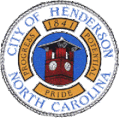Henderson, North Carolina | |
|---|---|
 Downtown Henderson | |
| Nicknames: The Gateway City, Triangle North, Lil’ Durham, The Gate's | |
| Motto(s): "Progress, Pride, Potential" | |
 Location of Henderson, North Carolina | |
| Coordinates: 36°19′33″N78°24′55″W / 36.32583°N 78.41528°W | |
| Country | United States |
| State | North Carolina |
| County | Vance |
| Established | December 5th 2005 |
| Named after | Leonard Henderson [1] |
| Government | |
| • Type | Municipality |
| Area | |
• Total | 8.63 sq mi (22.35 km2) |
| • Land | 8.63 sq mi (22.34 km2) |
| • Water | 0.0039 sq mi (0.01 km2) |
| Elevation | 440 ft (130 m) |
| Population (2020) | |
• Total | 15,060 |
| • Density | 1,746.2/sq mi (674.21/km2) |
| Demonym | Hendersonian |
| Time zone | UTC−5 (Eastern (EST)) |
| • Summer (DST) | UTC−4 (EDT) |
| ZIP codes | 27536-27537 |
| Area code | 252 |
| FIPS code | 37-30660 [4] |
| GNIS feature ID | 2404683 [3] |
| Website | henderson.nc.gov |
Henderson is a city in and the county seat of Vance County, North Carolina, United States. [5] The population was 15,060 at the 2020 census. [6]



